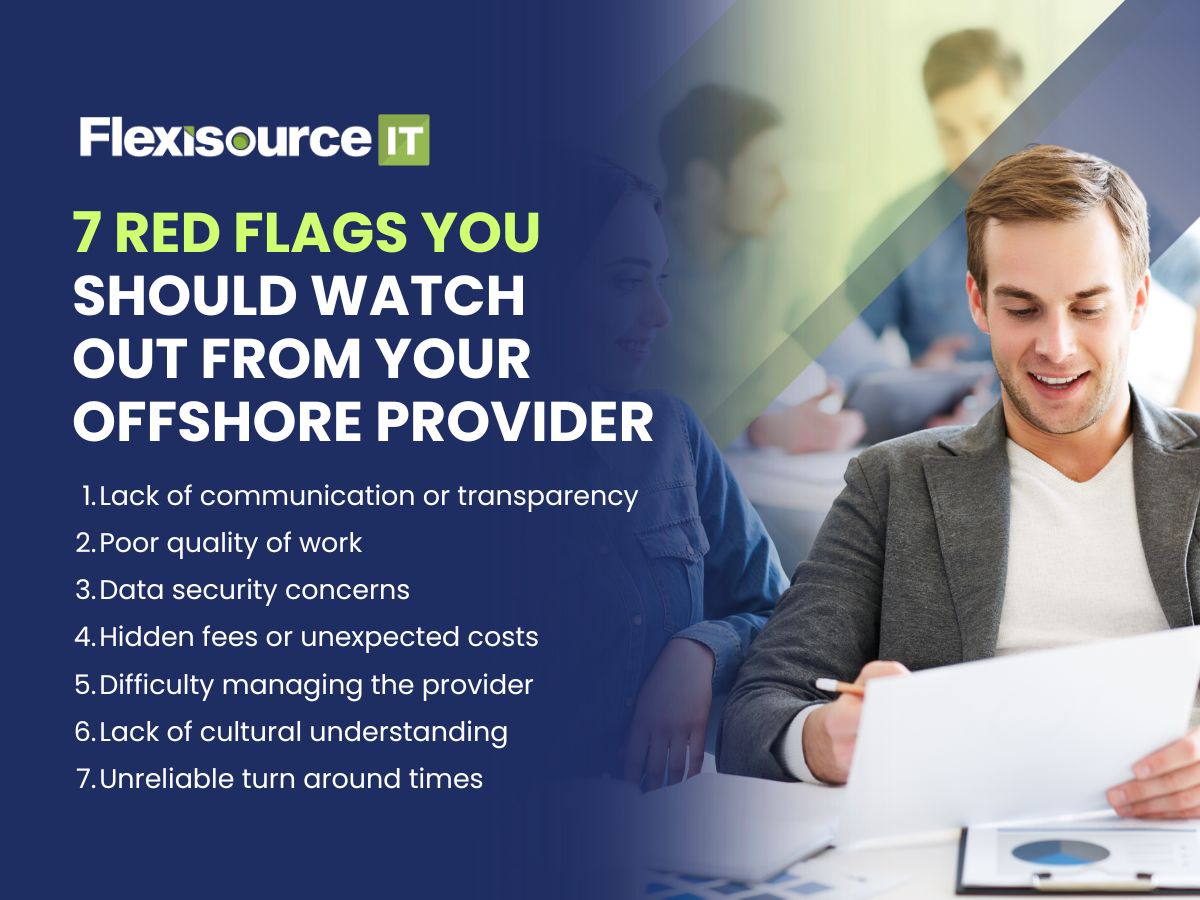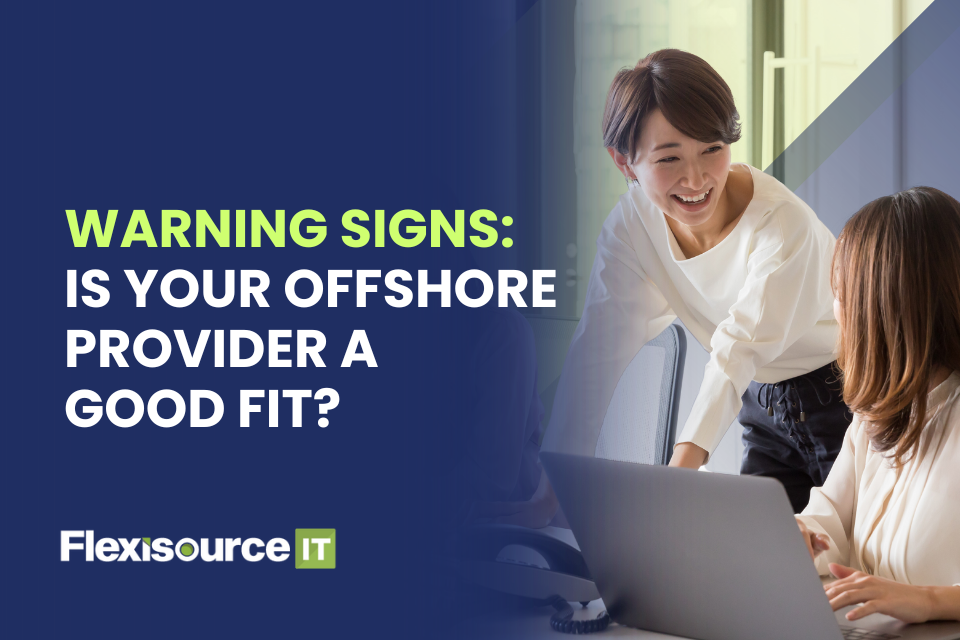Red flags with offshore providers are hard to swallow. Especially when the company has a good rapport with your own business. However, a good fit for your business shows positive results on the market and growth, not the other way around. If business owners continue to ignore the possible side effects of offshore providers already showing red flags it’s possible to lose a huge amount of growth, funding, and progress with one swift blow.
The benefits of hiring an offshore IT company are hard to ignore, regardless of the dangers. Everything becomes more cost-efficient, communicative, and productive, and the company’s overall growth increases. It’s one of the reasons why businesses will remain in contact with an offshore provider. However, this type of positive effect can only work with an outsourcing that fits perfectly into a company’s culture.
How do we know if an offshore provider is a good fit or not? Warning signs of a bad offshore provider are listed below so you can analyse and compare your own service providers. By doing so, you can figure out whether your provider is the best fit for you or if it’s time to move on to a new outsourcing company.
What is Offshore Outsourcing?
Outsourcing is the process used by private companies to hire services dedicated to their business growth from a third-party company. There are three types of outsourcing: nearshore, onshore, and offshore.
Offshore outsourcing stands out from nearshore and onshore because of the time zone and country difference between the companies that hire them. Thanks to the globalisation of the modern world, outsourcing has become a respectable career and a business opportunity that connects world-class specialists with growing businesses from distant locations.
Companies tend to hire offshore outsourcing to maintain IT infrastructures, internal operations, accounting, or call centers. It’s a lucrative business that only grows to increase further as the age of the modern digital world begins.
What are the benefits of Offshore Outsourcing?
Many businesses are willing to risk the chances of encountering red flags with offshore providers to obtain outsourced employees. This is because the benefits of offshore outsourcing outweigh the risks.
Offshore outsourcing is cost-effective, adaptive, scalable, and globally-recognised. The outsourced employees allow more room for resources to pour in with less than the amount of costs required for in-house employees.
Not only that, they’re also adaptable to any situation they’re placed in that requires sudden changes to daily tasks and maintenance. Their ability to maintain, expand, and deliver is what makes offshore outsourcing employees worth the risk.
However, if you can avoid the possibility of being partners with someone who does not fit your company’s interests, why wouldn’t you? Thankfully, these 7 red flags with offshore providers can give you a clue into your current provider’s stability.
7 Red Flags You Should Watch Out From Your Offshore Provider
Business setbacks because of outsourcing companies are unfortunate, but they happen. There are many offshore providers around the world and this means unstable and suspicious ones come from anywhere. To prevent you and your business from falling victim to suspicious outsourcing companies, check their behaviors with these red flags to leave the partnership before it’s too late.

Lack of Transparency
One of the most dangerous red flags with offshore providers is the lack of transparency. A big setback in growth even with great outsourcing companies is communication. That’s why offshore provider communication issues tend to be a catalyst to a fallout between a provider and their clients.
Is your offshore provider allowing you to communicate with the third-party employee that you hired? Or are they requesting you speak to them, and they relay your requests? Many offshore providers practice this form of communication. However, there are more effective outsourcing companies that allow flexible and direct discussions.
Being allowed to discuss openly with the outsourcing company and the third-party employee can encourage effective communication and transparency within the partnership. Lacking such open communication will lead to distrust, miscommunication, and confusion during the joint partnership.
While it sounds minimal, such a lack of transparency could lead to disastrous results for your company. Ensure that the offshore provider you’re talking with can do what you have asked them and set realistic expectations between the two of you.
Poor Work Quality
Some red flags with offshore providers, such as lack of trust, can lead to poor work quality. Whether it’s a demotivated outsourced employee, miscommunication, conflicts of interest, or poor work quality, it can lead to further setbacks along the way.
On the other hand, choosing the perfect offshore IT company that outputs exceptional work quality can give a significant boost to your company’s progress and sales.
How do you check if your offshore provider and its employees are doing a good job? It will all be based on their job results. Whether they’re from IT, accounting, or digital marketing, the results of their job efforts would easily be displayed. Meanwhile, their errors will be discussed for improvement.
If no improvements have been made and work quality further declines, consider it as a red flag.
Data Security Concerns
Data security in offshore outsourcing is a risky service. However, many businesses, once finding the most reliable partner, don’t feel it is as risky as they used to. Aside from the trust and familiarity brought out by their partnership, the offshore partner’s exceptional work ethic would continue their transactions.
What if they have no customer feedback, you’ve just met them, but they offer data security. Red flags with offshore providers can’t be seen at first glance. However, when it comes to data security, credibility is a must.
Signs of security breaches, data loss, or no security training with their employees can be red flags. Look for companies that agree to non-disclosure agreements and active monitoring with experienced cybersecurity specialists instead.
Unexpected Costs (Hidden Fees)
Are you worried that you have been gaining sudden costs more with your outsourced partner? That’s quite normal and is expected of some offshore projects. However, costs usually increase only when the project becomes more complex as it grows.
Receiving requests for unexpected costs early in the partnership is one of the red flags with offshore providers.
The lack of project management, including the money invested, will cause such situations. Take into consideration where these unexpected costs come from. If the equipment of your provider is out-of-date, that’s a red flag that you should take note of.
Another part of unexpected costs that could cause issues is when scalability comes to mind. Clear communication between the providers and the clients must be established before the initiating day of their partnership. This means costs that include the current tasks and future must be discussed to get a genuine understanding of the amount expected to be used.
Not only does it clear the air for outsourcing companies and business owners of any confusion with the cost, but it also minimises the number of unexpected costs and increases transparent communication. An offshore provider that does not want to engage in such communication may not be the best choice for you.
Poor Management
Speaking of project management, you can also find some red flags with offshore providers if they are disorganised and have poor management skills. This is especially risky for remote workers and collaborative teams that require consistent updates on who is currently doing what.
Lack of project management can lead to a repeat of tasks, neglecting other tasks, and a general lack of ability to deliver what they promised. Check-in with your offshore provider and observe how they respond to sudden changes or pressure. Failure to prevent poor management from seeping into your project can lead to expensive damages and repairs.
Poor Cultural Understanding
Red flags with offshore providers don’t always have to be project-based. Sometimes, it also has to do with customer relations and satisfaction. This is especially true for outsourced call center agents. A lack of cultural understanding can leave your customer feeling unheard and, at worst, disrespected.
Ensure that the offshore provider you’re planning to partner up with has an understanding of cultural differences. Not only does this mean they embrace diversity, but it also means that the company’s employees are expected to have the same mindset.
Empathetic outsourced employees who face the customers and your other employees learn to adjust quickly to their atmosphere. It’s a sign of professionalism and experience that no beginner can truly understand. Those with an open mind and knowledge of different cultures can quickly adapt to communication, and requirements, and are more open to adjustments.
Having an offshore provider with a lack of cultural understanding can lead to miscommunication, disruption in the tasks, and an overall negative mindset.
Delayed Turnarounds
Red flags with offshore providers also involve the duration of their delivery concerning the tasks you require of them. A lack of set deadlines, considerable amounts of extensions, and multiple errors despite the delays all point to a sign of inexperience and disorganisation.
An offshore provider and their employees should always deliver high-quality results at a reasonable and consistent turnaround date. Failure to do so is no cause for alarm. However, repeated delays reflect unreliability.
Business owners always expect what they pay for and must set realistic deadlines. However, the clients of the providers themselves cannot adjust repeatedly. Consider looking for a different offshore provider if repeated delays happen to your requests.
What to Do if You See Red Flags
After reading through all the possible warning signs and red flags with offshore providers, you might realise you’re involved with one. It’s not a cause for panic. A successful offshore outsourcing collaboration means mutual benefits between the two partners. If you do not receive what was initially agreed upon, there is no shame in considering negotiations.
Negotiate with your offshore provider and if possible, discuss improvements to ensure a better collaborative experience. Take a step back and evaluate your priorities on what you wish your offshore provider should do and take into account the pros and cons of your current provider.
If negotiations fall short and there are more risks than benefits with your current outsourcing partner, consider looking into alternate ones instead.
Conclusion
Did you learn some good news or bad news after understanding the red flags with offshore providers? Given the wide variety of outsourcing companies around the world, the chances of finding a great outsourcing partner come from the owner’s preparedness and knowledge of the great or bad qualities of outsourcing companies beforehand.
Still, if you’re having trouble looking into how to choose an offshore provider that’s good for your company, you don’t need to worry. You can discuss your current situation with us and explore solutions with our outsourcing experts. Get a free consultation with Flexisource IT.





